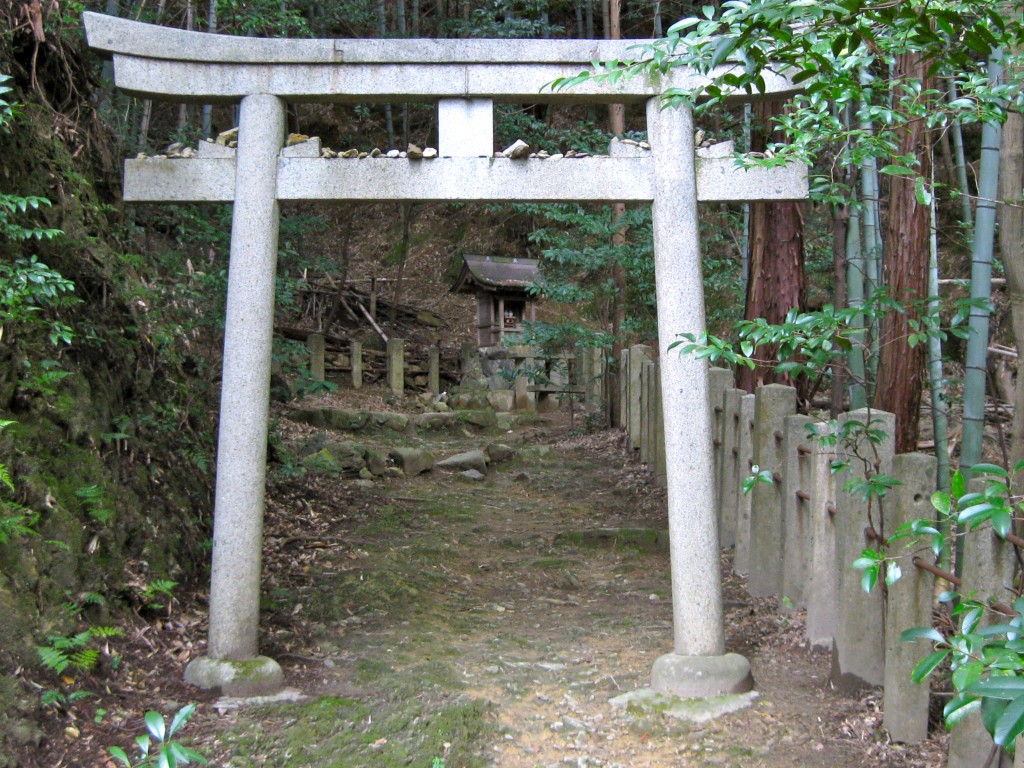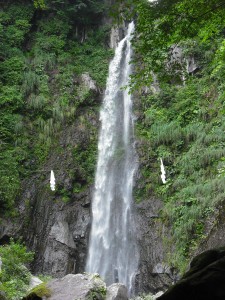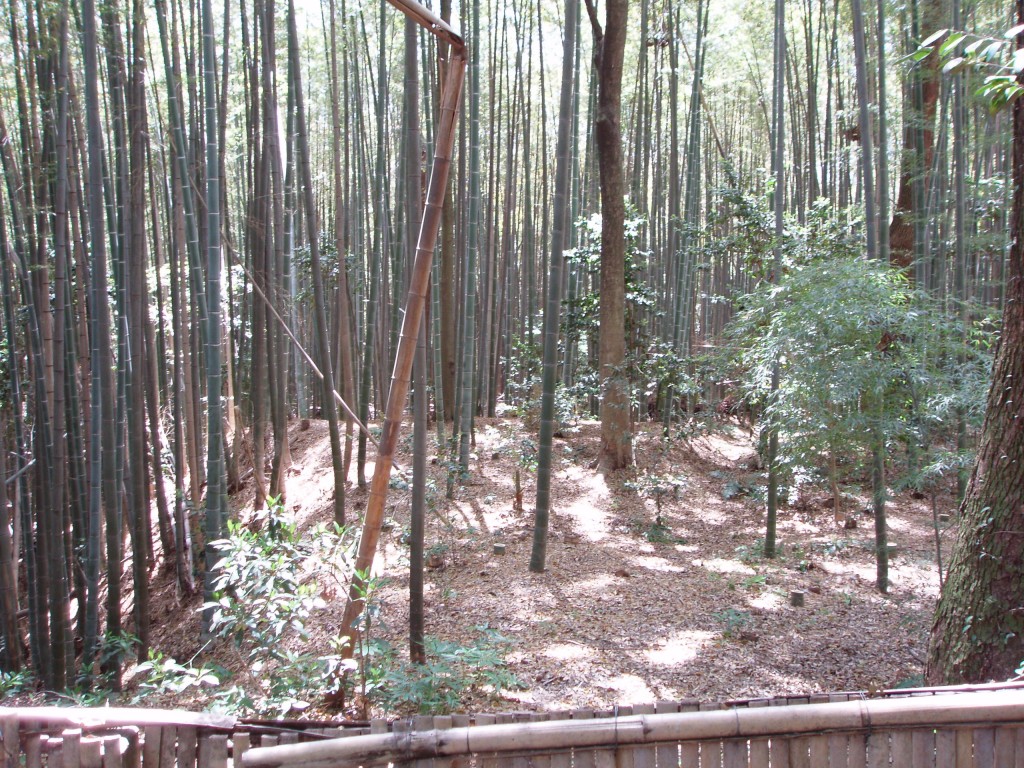
Himukai Jinja in Kyoto
Animism is sometimes cast as primitive, or seen as outmoded by contrast with ‘sophisticated religions’ like Christianity and Buddhism. But with the rise of paganism and neo-shamanism, animism is again gaining ground in the West. Perhaps it never really went away…
And this our life exempt from public haunt,
Finds tongues in trees, books in the running brooks,
Sermons in stones, and good in everything.
– As You Like It Act II, Sc. I
An intriguing paper by Bruce Charlton, reader in Evolutionary Psychiatry at the University of Newcastle, puts forward the notion that animism is basic to the human view of life. It is after all how we perceive the world as children but which we are schooled out of subsequently. The result is alienation from the world around us and a tendency to see nature as simply dead material to be used and abused. Worst of all, we even treat animals that way, as if they are bereft of feeling or sense.
 But for Charlton, “animism remains the basic underlying mode of human thinking, and animism can be recovered.” He contrasts the world of the hunter-gatherer, who had concern for the animals he killed, with modern mechanistic thinking that has no pity for the factory animals served up as cheap and convenient food. “Hunter-gatherer knowledge is dependent on the most intimate possible connection with the world and the creatures that live in it.” he writes.
But for Charlton, “animism remains the basic underlying mode of human thinking, and animism can be recovered.” He contrasts the world of the hunter-gatherer, who had concern for the animals he killed, with modern mechanistic thinking that has no pity for the factory animals served up as cheap and convenient food. “Hunter-gatherer knowledge is dependent on the most intimate possible connection with the world and the creatures that live in it.” he writes.
Of course the world of the hunter-gatherer has long passed, and it’s impossible to turn back the clock. So how are we to recover the sense of being part of a living world, rather than an alienated, manipulating controller? Well, one way is through detachment from the social systems that maintain tyranny over the earth. This can take all kinds of forms, from outright rejection and dropping out to vegetarianism, self-sufficiency, and insistence on organic food.
There’s also another path, suggests Charlton: altered states of consciousness. I know at this point what readers might be thinking, for like others I’ve had mind-altering drugs myself. But what Charlton wants to focus on is the kind of trance state beloved of the neo-shamanic movement that has “mushroomed” in recent years. Typically drumming and hypnotic dancing are used, but some people are able to self-induce a similar state of mind. For some the dream-state is more real than the material reality of consumer capitalism. Carl Jung referred to the freeing of the mind in this way as ‘active imagination’.
it is in this semi-trance state that Carter sees the possibility of recovering a sense of belonging, or reclaiming animistic thinking. Indeed, he sees the trend as likely to continue in the future, and this ties in with the theory of another evolutionary psychologist whose book I recently came across who believes that animism forms the bedrock of the human mind which has been forcibly suppressed by the likes of Christianity and other axial religions. In this respect it may be no coincidence that the bestsellers of the age are books with an animistic vision, such as Lord of the Rings and Harry Potter. ‘We’ve got to get ourselves back to the Garden,’ sang Joni Mitchell in the 1960s, and animism might just be the way…
^^^^^^^^^^^^^^^^^^^^^^^^^^^^^^^^
“When the individual feels connected to the cosmos as a whole, it becomes clear that ecological awareness is truly spiritual.”
– Fritjof Capra
*********************************************************************************************************************
Bruce Charlton’s paper is entitled ‘Alienation, Neo-Shamanism and Recovered Animism’ (2002). It is available at his homepage, together with other papers such as ‘The Meaning of Life’.


When I first read Dr. Charlton’s article I found it so incredibly inspiring that I hungrily pursued more of his works. Unfortunately, I discovered that he has since rejected this paper (as well as other related pieces) as “fundamentally flawed” (or some similar language) without further elaboration (see his blog). If a reader wants clarification on the matter, they must email him directly for an explanation. I have not chosen to do so. I am disappointed that he has chosen to cast aside the subject in such a wholesale manner. His eloquence & understanding of animism worked beautifully together to communicate ideas that are often difficult to articulate.
So delighted to stumble upon this blog. Animism-related websites/blogs are few & far between. It brings me great joy when I find one. Thank you.
To anyone interested in an approach to modern animism, I highly recommend the work of David Abram, particularly the books The Spell of the Sensuous, and Becoming Animal: an Earthly Cosmology…
Thanks to Moma and Erik for the feedback… I didn’t know of David Abram but will have to check him out when I get the time… for the moment though I’m buried in preparations for a trip to two of Japan’s World Heritage Sites, both of which are nature reserves of a special nature – Shiretoko in north-east Hokkaido, and Shirakami Sanchi in northern Tohoku. There should be plenty of opportunity to commune with nature, but hopefully not with the very spirit-filled bears!
Green Shinto friend John Hanagan has written in to point out a video of the ever wonderful Alan Watts in which he lays out a Buddhist vision of animism. It reminds me of a talk he once gave about the earth as a living rock that ‘peoples’, just as humans have babies. In this ten-minute talk on youtube, the much missed Watts explains how organism and environment are all one process. “So don’t differentiate yourself and say ‘I am a living organism in a world made of a lot of dead junk, rocks and stuff,” he concludes. ‘It all goes together. Those rocks are just as much you as your fingernails. You need rocks – what are you going to stand on?” See http://www.youtube.com/watch?v=yeyss0Ng4T8&feature=em-share_video_user
Well said! I can’t wait to explore your blog more deeply. For some, you said, the dream-state is more real than the material reality of consumer capitalism. I would say that the animist reality is more real than the consumerist reality, AND that it is both material and spiritual, as all animist reality is both material and spiritual. All material being is alive, intelligent and ensouled. I would be delighted to have you visit my blog and comment on the animist posts. I’d love to get your insights.
Best wishes,
Puny
Thank you to ‘Puny Human’ for that, and anyone looking for some lively comments from an animist perspective should click on the name above her posting to be taken to her webbog.
I’d also advise anyone looking for an animist rationale to take a look at the Green Shinto posting on Watts and environmental holism. He not only gives pause for thought, but provides a very convincing take on the matter.